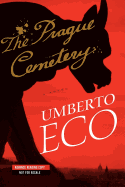
We enter into the world of Umberto Eco's new novel via a "Narrator" who brings the Reader into a darkened room where an elderly man hunches over a desk writing. The Narrator doesn't know who he is or what he's writing. We'll find out together. It turns out to be a diary, dated March 24, 1897, and Eco begins to tell us a story via the diary, with some sections summarized by the Narrator, "so as not to unduly bore the Reader."
The diarist is a Jew hater, Simone Simonini, and he's telling us how he created the infamous Protocols of the Elders of Zion, the phony plan for world domination supposedly written by a group of learned rabbis in the Prague Cemetery. Simonini is fictional, but the Protocols are real, first published in Russia in 1903 and invoked by anti-Semites from Henry Ford to Adolf Hitler. Thus Eco plunges us headfirst into the tumultuous and conspiratorial world of late 19th-century Europe, mixing real history with his fiction. (Black-and-white illustrations throughout The Prague Cemetery further mimic the look and feel of a genuine 19th-century novel.) The results are often intriguing, erudite tales that make heavy demands on the Reader and offer varying rewards. Overall, however, Eco succeeds in taking us on a dark, unsettling voyage into an insane mind filled with the worst kind of evil. --Thomas Lavoie, former publisher

